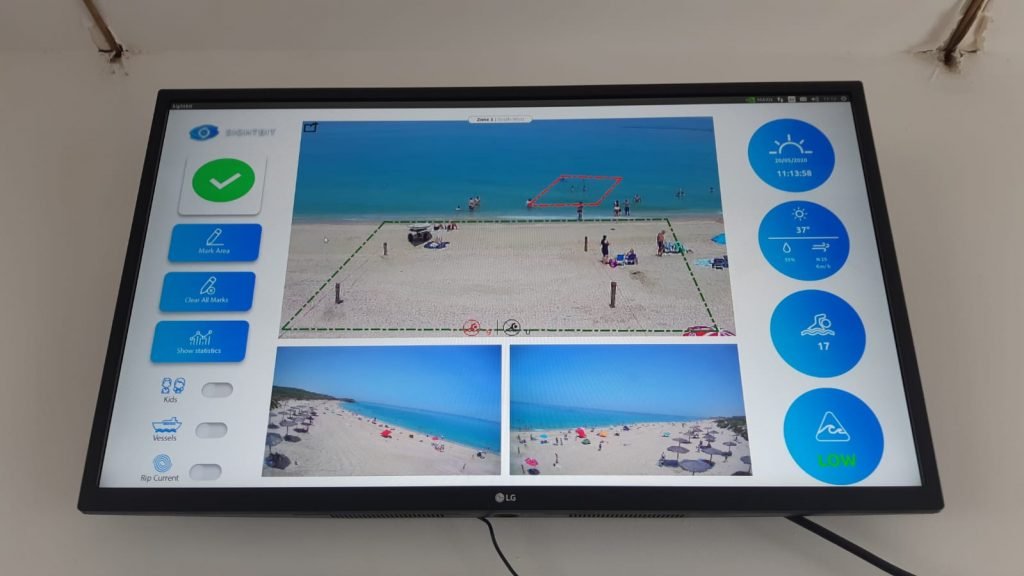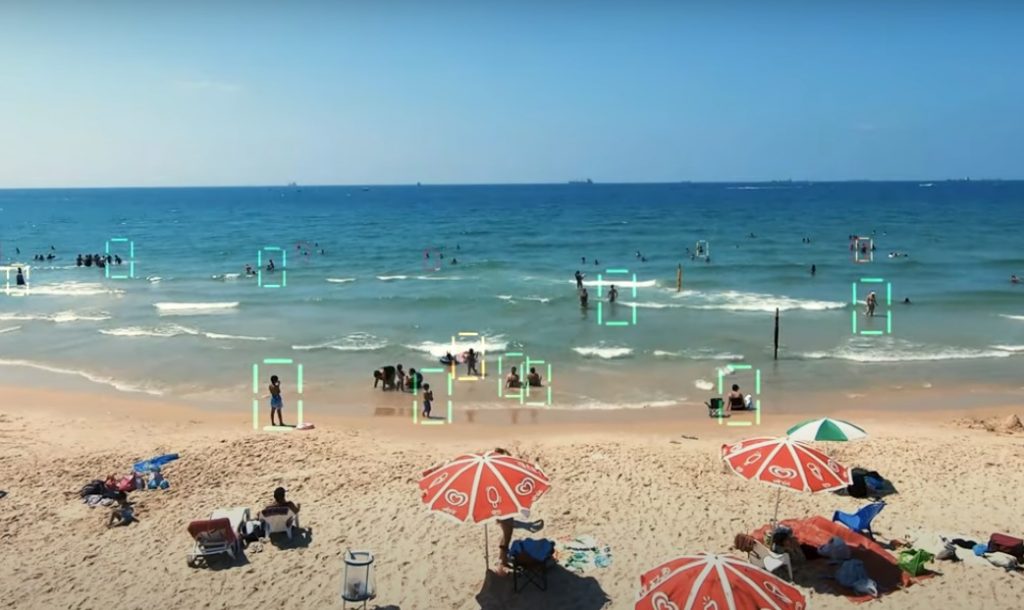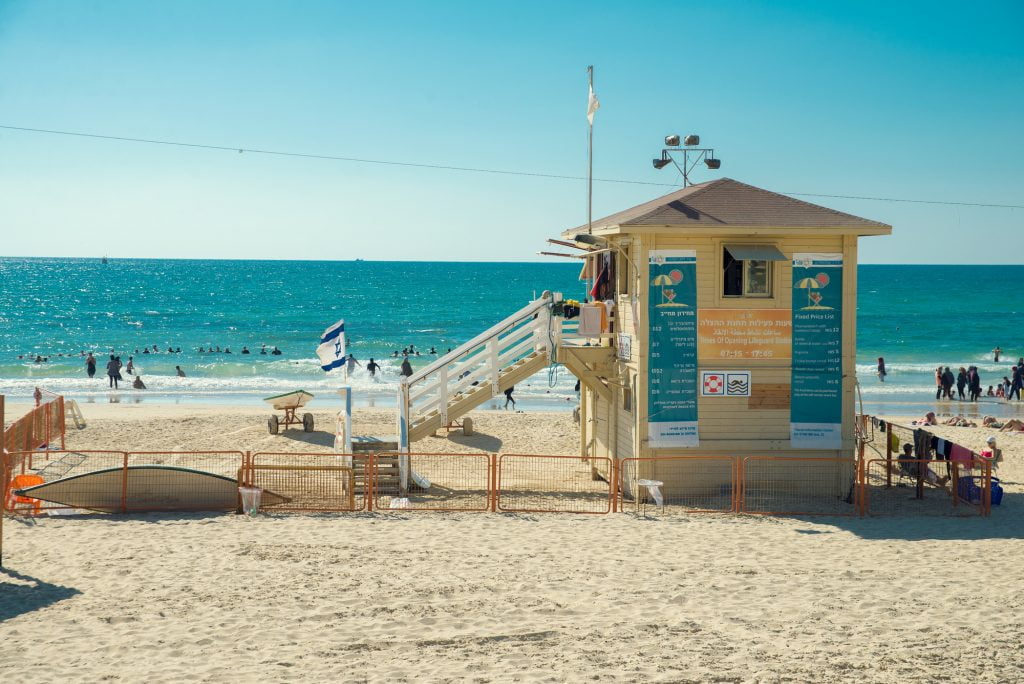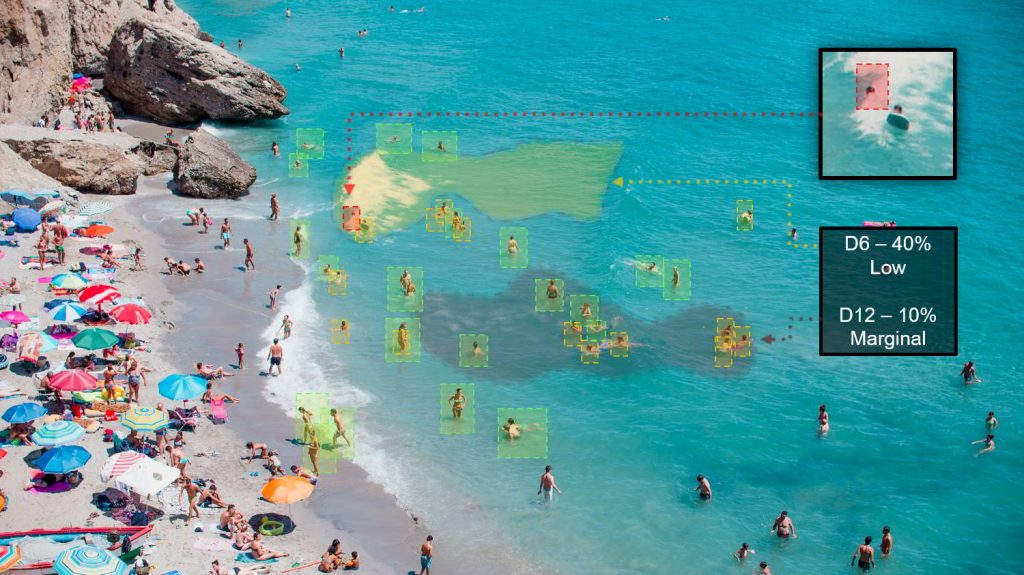Amid a sweltering heatwave, beach season officially kicked off in Israel last Wednesday. For the first time since seaside closures began in early April, scores of bathers flocked to more than 100 beaches off the Mediterranean coast to soak up the sun and splash in the waves, as the spread of the COVID-19 infections slowed throughout the country.
As Israelis dive into the muddled waters of the “new normal” over the next few summer months, lifeguards are returning to their turf — monitoring beach crowds, warning swimmers about potential hazards such as rip currents and undertows, and, of course, preventing drowning.
But lifeguards are only human. While they can certainly reduce the risk of drowning, they can only cover a certain expanse of beach at a time. For some of the bigger beaches in Israel, that gather upwards of 10,000 swimmers and visitors on a daily basis, this can be problematic.
Sightbit, the Israeli startup leveraging AI tech to alert lifeguards when swimmers are in danger, has launched its first pilot program of the season at Palmachim Beach, one of Israel’s most popular beaches. The program, done in collaboration with the Israel Nature and Parks Authority, aims to turn the area into one of the first “smart” beaches in Israel powered by cutting-edge AI and computer vision tech that will make it easier to spot and prevent drowning victims.

“Sightbit is, in essence, an AI lifeguard — so our software acts as an additional lifeguard by flagging threats to swimmers,” Minna Shezaf, co-founder, and chief marketing officer at the company, tells NoCamels. Special cameras are used to film the beach’s swim areas and algorithms analyze the footage in real-time to flag incidences.
“We display alerts on a monitor, which is stationed at the lifeguard tower. We also sound alarms when swimmers are in danger,” she said.
“I believe this is the first time AI deep learning technology has ever been used to save lives at the beach,” adds Sightbit’s CTO Gadi Kovler.
Located south of Rishon Lezion and Nahal Sorek, Palmachim Beach near Kibbutz Palmachim is made up of a coastal area that has been declared a public park and stretches over five miles. It attracts approximately a million swimmers and visitors every year, according to Sighbit.
On an average summer day, they are as many as 10,000-15,0000 swimmers.
As part of the pilot, Sightbit’s camera system expands the lifeguard’s scope of observation and enables rescuers to respond faster to any dangers.
The system maps bathers’ locations, warns of potential drowning hazards, changes in sea data – such as unexpected waves and currents – and provides control over the movement of various populations in general, and young children in particular.
“At Palmachim Beach, the lifeguards say that one big benefit is that our cameras are stationed in places where they have trouble seeing. They have trouble seeing swimmers way off to the side. Maybe they have to pull out a set of binoculars to try to get a look at them. But with Sightbit, they can see those swimmers right up on the screen,” Shezaf said.
Sightbit has three cameras stationed around each lifeguard tower at Pamalchim, but Shezaf also tells NoCamels the beach is building a cement-like camera stand that will use the camera system at all times, including when lifeguards are not working. She also said that Sightbit will place additional cameras along the length of the beach later on in the summer.
Sign up for our free weekly newsletter
Subscribe
The Palmachim project is Sighbit’s first full-scale pilot in Israel. The company conducted initial pilots last fall at several beaches across the county, including beaches in Ashkelon and Nahariya.
The company has been invited to conduct trails at beaches across Israel, Europe, and the United States.
Drowning prevention tech
Sightbit was founded in 2018 by Shezaf, Netanel Eliav, Gadi Kolver, and Adam Bismut, then students at Ben-Gurion University (BGU). It received financial backing from Cactus Capital, a venture arm of BGU and the first student-run university venture capital firm in Israel.
In addition to its real-time alerts, water hazards, and warnings to swimmers, Sightbit also provides crowding management solutions, updates on weather conditions, and offers estimates on how many lifeguards are needed on a given day to safely monitor swimmers.

Israeli beaches usually have three lifeguards stationed at every tower which is impressive, says Shezaf. But they can’t monitor everything at all times. It’s also an expense “so the beaches can’t actually afford to guard all the areas of shorelines they’ve got,” she explains.
Sightbit’s goal in the short term is not to replace lifeguards but to be “a tool for lifeguards to use,” according to Shezaf. She stresses that while the team is currently looking to assist lifeguards so they can do their jobs even better, in the long run, their system may be an optimized solution for cities and beach authorities.
Riding the wave
Over the beach season last year, 46 drownings were recorded between April and October, according to data released last fall by Magen David Adom (Hebrew.) Over that same period, MDA paramedics treated 228 people for water injuries, including 11 who needed CPR.
The number of drowning victims decreased from 72 in 2018 to 46 in 2019, but Shezaf thinks it can go down even further with the help of Sightbit.

Many of Israel’s drowning victims over the past year were also found in areas where swimming is prohibited. “There are many non-designated areas in Israel where people swim all the time and nobody’s guarding them because it’s just not cost-effective,” she explains.
Sightbit’s goal is to also have their camera systems in those areas too, to be able to warn beach rescuers and first responders when an incident is occurring in order to have them respond quickly.
“Humans aren’t optimized for sitting in a tower and tracking swimmers. It’s just not something that people are built for. When Sightbit can free up some of the lifeguards that are currently doing that, then the possibilities are really exciting. So you can assign more lifeguards to patrol duty or headquarters and you can put Sightbit systems on a longer stretch of shoreline, not just where you’ve got towers,” Shezaf says.
Related posts

Editors’ & Readers’ Choice: 10 Favorite NoCamels Articles

Forward Facing: What Does The Future Hold For Israeli High-Tech?

Impact Innovation: Israeli Startups That Could Shape Our Future






Facebook comments